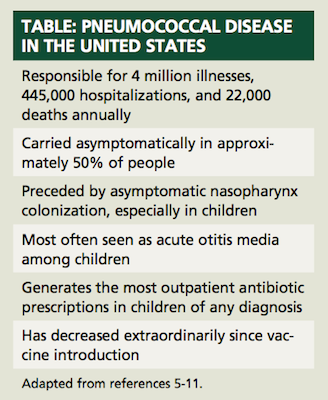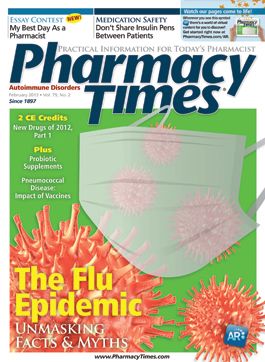Publication
Article
Pharmacy Times
Pneumococcal Disease: Under the Pressure of Vaccination
Author(s):
Preventive measures and herd immunity are having a major impact on disease prevalence.
Preventive measures and herd immunity are having a major impact on disease prevalence.
Streptococcus pneumoniae (pneumococcus) infection, a serious global problem that is the leading cause of pneumonia and other life-threatening illnesses, is vaccine preventable. This gram-positive bacterium has more than 90 known serotypes and 46 serogroups determined by the specific bacterium’s capsule polysaccharide composition. Humans can spread this bacteria via airborne droplets through coughing, sneezing, and even a bout of uncontrollable laughter.1,2 All serotypes may cause disease—especially otitis media (OM), sinusitis, and bronchitis.
A comparatively limited number of serotypes tend to enter the body through sterile environments, such as blood, cerebrospinal fluid, pleural fluid, joint fluid, or pericardial fluid. These more serious cases are considered invasive pneumococcal disease (IPD). The Centers for Disease Control and Prevention’s Active Bacterial Core Surveillance tracks IPD data, which indicate that IPD occurs most often in the very young and the elderly.2,3 Roughly 10% of all IPD patients die; here, too, the youngest and oldest patients are at highest risk.3,4 The Table5-11 describes pneumococcal disease’s impact in the United States.

Pneumococcal Vaccines
Since 2000, routine childhood pneumococcal conjugate vaccine has decreased rates of IPD caused by pneumococcal serotypes covered by the vaccine more than 90%. Overall rates of invasive disease in the entire population have decreased almost 50%, and by 75% in children younger than 5 years.
Unvaccinated older children and adults also experience less pneumococcal disease due to herd immunity.3,12,13 Health scientists were amazed and delighted when widespread uptake of 7-valent pneumococcal conjugate vaccine (PCV7) immunization dramatically decreased pneumococcal disease within a year and eliminated IPD caused by serotypes contained in the vaccine completely in children younger than 5 years in the United States. Overall, the vaccine reduced preventable infection by 94% in all ages.14
Pneumococcal vaccines are available as polysaccharide (containing capsular pneumococcal polysaccharide antigens) or conjugate (containing immunogenic non-pneumococcal protein conjugated to individual pneumococcal polysaccharides) varieties.
Pneumococcal Vaccines over Time
Since 1983, the Advisory Committee on Immunization Practices (ACIP) has recommended a pneumococcal polysaccharide vaccine targeting 23 (PPV23) of the most common S pneumoniae serotypes for children older than 2 years who have certain underlying chronic medical conditions and adults older than 65 years.5,15 Its limitation is that children younger than 2 cannot mount an adequate response to this vaccine, and its effectiveness is 57% to 75%. The PPV vaccine remains an important option for patients who have HIV or are otherwise immunocompromised. Given the high burden of IPD caused by serotypes in PPV23 but not newer vaccines, broader protection is hypothesized.
In February 2000, the FDA licensed PCV7, which is active against serotypes 4, 6B, 9V, 14, 18C, 19F, and 23F, for use in infants and young children. Pivotal trials showed that PCV7 was safe and highly effective (~97%) against IPD, moderately effective against pneumonia, and somewhat effective in reducing OM episodes and related office visits.16-18 Consequently, ACIP recommended routine use of PCV7 for all children aged 2 to 23 months and for children aged 24 to 59 months with anatomic or functional asplenia, sickle cell disease (SCD), any immunocompromising condition, or chronic illness.11 In 2007, the ACIP expanded its recommendation to include all children aged 2 to 59 months because of this vaccine’s effectiveness.19
Increases in disease caused by serotypes not included in PCV7 (ie, replacement disease) occurred in children and certain adult populations with underlying illnesses. These increases were small compared with the overall reduction in disease.20,21 Regardless, coverage was not ideal. PCV7 covered serotype 6B and provided some partial cross coverage against 6A. Many studies revealed that following PCV7 vaccination, nasopharyngeal carriage of 6A persisted and 6A-related IPD could occur in children. Many health authorities around the world reported increased incidence of multidrug-resistant 19A, particularly in the very young and the elderly. Several other serotypes remained problematic, especially 19A.22-26
In February 2010, a 13-valent pneumococcal conjugate vaccine (PCV13) replaced PCV7.27 PCV13 contains the 7 serotypes included in PCV7 and 6 additional serotypes (1, 3, 5, 6A, 7F, and 19A). PCV13 is approved for prevention of IPD caused by the 13 serotypes in the vaccine among infants and young children and prevention of OM caused by the 7 serotypes covered by PCV7. There is little evidence regarding the efficacy data for prevention of OM caused by the 6 additional serotypes. Health scientists hope that the introduction of PCV13 will reduce cases of IPD due to the 6 additional serotypes covered by the vaccine.
ACIP recommends PCV13 for all children aged 2 months to 5 years. ACIP also recommends PCV13 for children aged 60 to 71 months with underlying medical conditions that increase their risk for pneumococcal disease or complications. In 2011, the FDA approved this vaccine for individuals 50 years and older to prevent pneumonia and IPD.27
Serotype Replacement and Nonvaccine Serotypes
Serotype replacement takes 1 of 2 pathways28:
- An increase in prevalence of serotypes already present in the population occurs
- Serotypes that had been unable to cause disease until the vaccine eliminated more pathogenic serotypes appear and spread; in other words, the new serotypes emerge when their competition is eliminated
How serotype replacement occurs is controversial. One group of experts believes it’s a multifaceted phenomenon (ie, new serotypes develop, similar serotypes co-transform [eg, 19F to 19A conferring penicillin resistance], or bacteria undergo capsular switch), and that time and geography govern serotype distribution and disease development.29
A second group believes the noteworthy increases in non-PCV7 serotypes in some populations are related to changes in antibiotic use, environmental conditions, frequency of comorbid conditions, immunosuppression, or other factors.29 Most agree that even if immunization had not been aggressive, specific serotypes may have increased in frequency simply due to capsular switching.30
Conclusion
The dramatic change in the incidence of pneumococcal infection, especially IPD, is a testimony that vaccination works. Even though some new serotypes have emerged, the increase in these strains has not eroded our progress significantly. Health care clinicians need to promote vaccination, referring to current vaccination recommendations for appropriate schedules. Research is under way to develop safe vaccines with broader coverage. Regardless of the patient’s age, vaccination prevents significant morbidity and mortality.
Ms. Wick is a visiting professor at the University of Connecticut School of Pharmacy and a freelance writer from Virginia.
References:
- Nuorti JP, Whitney CG. Prevention of pneumococcal disease among infants and children - use of 13-valent pneumococcal conjugate vaccine and 23-valent pneumococcal polysaccharide vaccine - recommendations of the Advisory Committee on Immunization Practices (ACIP). MMWR Recomm Rep. 2010;59:1-18.
- Thigpen MC, Whitney CG, Messonnier NE, et al. Bacterial meningitis in the United States, 1998-2007. N Engl J Med. 2011;364:2016-2025.
- Center for Disease Control. Active Bacterial Core Surveillance (ABCs) Report; Emerging Infections Program Network; Streptococcus pneumoniae [database online]. www.cdc.gov/abcs/index.htm. Published 2010. Updated April 2012.
- Robinson KA, Baughman W, Rothrock G, et al. Epidemiology of invasive Streptococcus pneumoniae infections in the United States, 1995-1998: opportunities for prevention in the conjugate vaccine era. JAMA. 2001;285:1729-1735.
- Centers for Disease Control and Prevention. Prevention of pneumococcal disease. MMWR. 1997; 46(RR-8):1-20.
- Dowell SF, Marcy SM, Phillips WR, Gerber MA, Schwartz B. Otitis media—principles of judicious use of antimicrobial agents. Pediatrics. 1998;101:165-171.
- Block SL, Hedrick J, Harrison CJ, et al. Community-wide vaccination with the heptavalent pneumococcal conjugate significantly alters the microbiology of acute otitis media. Pediatr Infect Dis J. 2004;23:829-833.
- Casey JR, Pichichero ME. Changes in frequency and pathogens causing acute otitis media in 1995-2003. Pediatr Infect Dis J. 2004;23(9): 824-828.
- Huang SS, Johnson KM, Ray GT, et al. Healthcare utilization and cost of pneumococcal disease in the United States. Vaccine. 2011;29:3398-3412.
- Bogaert D, De Groot R, Hermans PW. Streptococcus pneumoniae colonisation: the key to pneumococcal disease. Lancet Infect Dis. 2004;4:144-154.
- Centers for Disease Control and Prevention. Preventing pneumococcal disease among infants and young children: recommendations of the Advisory Committee on Immunization Practices (ACIP). MMWR. 2000;49(No. RR-9):1-35.
- Committee on Infectious Diseases; American Academy of Pediatrics. Pneumococcal infections. In: Pickering LK, Baker CJ, Long SS, McMillan JA. Red Book 2009 Report of the Committee on Infectious Diseases. 28th American Academy of Pediatrics. 2009:525-335.
- Centers for Disease Control and Prevention (CDC). Invasive pneumococcal disease in children 5 years after conjugate vaccine introduction--eight states, 1998-2005. MMWR. 2008;57:144-148.
- O’Brien KL, Wolfson LJ, Watt JP, et al. Burden of disease caused by Streptococcus pneumoniae in children younger than 5 years: global estimates. Lancet. 2009;374:893-902.
- Centers for Disease Control and Prevention. Updated recommendations for prevention of invasive pneumococcal disease among adults using the 23-valent pneumococcal polysaccharide vaccine (PPSV23). MMWR. 2010;59:1102-1106.
- Black S, Shinefield H, Fireman B, et al. Efficacy, safety and immunogenicity of heptavalent pneumococcal conjugate vaccine in children. Northern California Kaiser Permanente Vaccine Study Center Group. Pediatr Infect Dis J. 2000;19:187-195.
- Black SB, Shinefield HR, Ling S, et al. Effectiveness of heptavalent pneumococcal conjugate vaccine in children younger than five years of age for prevention of pneumonia. Pediatr Infect Dis J. 2002;21:810-815.
- Eskola J, Kilpi T, Palmu A, et al. Efficacy of a pneumococcal conjugate vaccine against acute otitis media. N Engl J Med. 2001;344:403-409.
- Centers for Disease Control and Prevention. Updated recommendation from the Advisory Committee on Immunization Practices (ACIP) for use of 7-valent pneumococcal conjugate vaccine (PCV7) in children aged 24-59 months who are not completely vaccinated. MMWR. 2008;57:343-344.
- Centers for Disease Control and Prevention. Direct and indirect effects of routine vaccination of children with 7-valent pneumococcal conjugate vaccine on incidence of invasive pneumococcal disease--United States, 1998-2003. MMWR 2005;54:893-897.
- Flannery B, Heffernan RT, Harrison LH, et al. Changes in invasive pneumococcal disease among HIV-infected adults living in the era of childhood pneumococcal immunization. Ann Intern Med. 2006;144:1-9.
- Byington CL, Hulten KG, Ampofo K, et al. Molecular epidemiology of pediatric pneumococcal empyema from 2001 to 2007 in Utah. J Clin Microbiol. 2010;48:520-525.
- O’Dempsey TJ, McArdle TF, Lloyd-Evans N, et al. Pneumococcal disease among children in a rural area of West Africa. Pediatr Infect Dis J. 1996;5:431-437.
- Muñoz-Almagro C, Jordan I, Gene A, Latorre C, Garcia-Garcia JJ, Pallares R. Emergence of invasive pneumococcal disease caused by nonvaccine serotypes in the era of 7-valent conjugate vaccine. Clin Infect Dis. 2008;46:174-182.
- Whitney CG, Farley MM, Hadler J, et al. Decline in invasive pneumococcal disease after the introduction of protein-polysaccharide conjugate vaccine. N Engl J Med. 2003;348:1737-1346.
- Aaberge I. Experience with pneumoccocal conjugate vaccine in Norway. Expert Rev Vaccines. 2009;8:159-165.
- Centers for Disease Control and Prevention. Licensure of a 13-valent pneumococcal conjugate vaccine (PCV13) and recommendations for use among children - Advisory Committee on Immunization Practices (ACIP), 2010. MMWR. 2010;59:258-261.
- Lipsitch M. Bacterial vaccines and serotype replacement: lessons from Haemophilus influenzae and prospects for Streptococcus pneumoniae. Emerg Infect Dis. 1999;5:336-345.
- Pilishvili T, Lexau C, Farley MM et al. Sustained reductions in invasive pneumococcal disease in the era of conjugate vaccine. J Infec Dis. 2010;201:32-41.
- Rose M, Zielen S. Impact of infant immunization programs with pneumococcal conjugate vaccine in Europe. Expert Rev Vaccines. 2009;8:1351-1364.







